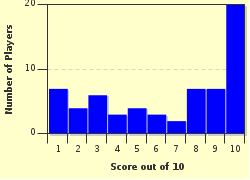Quiz Answer Key and Fun Facts
1. In what year was Grierson born?
2. Grierson was attracted to filmmaking by his post-graduate studies of mass media in the USA. However, what subject did he originally study at Glasgow University?
3. During his time in the USA, he became a film critic and is credited with first using the term 'documentary' with regard to a film. To which film did he first apply this word?
4. On his return to Britain in the late 1920s, Grierson became Assistant Films Officer at which organisation?
5. Grierson's first film was called "Drifters". It was produced in 1929 and documented the work of the Scottish herring fishing fleet. It premièred on a London double bill with which other classic film?
6. In 1933 Grierson joined the Post Office film unit, where he subsequently produced "Night Mail" (1936), one of the most famous of his works. It was the story of the Royal Mail express train from London to Edinburgh and was set to music by Benjamin Britten. Which poet wrote the commentary?
7. In 1939 Grierson left Britain and moved back to North America and created which highly regarded documentary unit?
8. Grierson left North America at the end of WWII - he was investigated for alleged "communist" sympathies. He went to work for UNESCO as the first Director of Mass Communications and Public Information - where was he based?
9. In the mid 1950s Grierson returned to Scotland and persuaded Roy Thomson, the Canadian millionaire who owned an independent TV station, to create which public affairs programme?
10. In his last few years Grierson was invited to lecture at which Canadian University?
Source: Author
Glaswegian
This quiz was reviewed by FunTrivia editor
gtho4 before going online.
Any errors found in FunTrivia content are routinely corrected through our feedback system.

